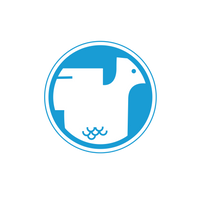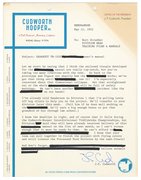
Cudworth-Hooper
Cudworth-Hooper began in the 1920s as a supplier of farming equipment, and as their success with hog oilers grew, so did their inventory. Today there are over 36 divisions of Cudworth-Hooper, making them one of the largest manufacturers in the world. Their catalogues have grown larger every year - since they have never discontinued an item, only adding to their product list - so a complete catalog today numbers nearly as many volumes as the Complete Oxford English Dictionary.
Before getting his big break, Dooley worked for a number of years illustrating hog oilers for Cudworth-Hooper's successful line of agricultural and industrial equipment. While not exactly a comedy training ground (though 'hog oiler' sounds like a pretty hilarious piece of equipment), working for Cudworth-Hooper allowed Dooley to hone his drafting skills and keep working with his drawing tools.
After getting his big break to create the comic strip Frank and His Friend, Dooley was quoted as saying that he would never buy any Cudworth-Hooper appliances for the family home. "Not once I've seen how they're made," he said.
History
Hog Oiler
A hog oiler is a mechanical device employed on farms to be used by hogs to provide relief from insects and offer skin protection. It consists of a reservoir to hold oil, and a means to distribute the oil onto the hog, often via grooved wheels or cylinders. Hogs seeking relief rub up against a wheel (or cylinder) causing it to rotate and dispense oil onto their bodies.
Like many vintage farm implements, hog oilers have a loyal following of collectors. Prices paid by collectors can vary widely, based on size, functions, and condition of the machine. Smaller hog oilers can be purchased for sometimes thirty dollars or less, while the rarest models have asking prices in the thousands. The majority of hog oiler finds today are in "hog belt" of the upper midwest United States.
Cudworth-Hooper 1952 Memorandum

This memo was sent from Cudworth-Hooper President J.P. Cudworth to Burt Stradder, Division Head of Training Films & Manuals, which was one of the 14 divisions the company had at that time.
Like much of the printed ephemera associated with the Gadabout, this was from the estate of Howard Dillinger. It was included in the package which contained the approval for printing the Gadabout TM-1050 Manual, which was signed by Stradder.
The memo makes reference to a number of concerns Cudworth had with the project, including the functioning of the dimensional collapse, as well as overall timing on the production.
The memo also mentions the Cudworth-Hooper Interdivisional Tiddlywinks Championships, which are still taken quite seriously by employees of the company.
Cudworth-Hooper: From Hog Oilers to Businessmen
With a company as large as Cudworth Hooper, manufacturers of everything from gloves to Gadabouts, it’s easy to forget that even this huge corporation – with 36 divisions, they’re one of the largest manufacturers in the world – began from humble beginnings. And it doesn’t get any more humble than hog oilers.
Walter Horatio Hooper was born August 8, 1899 in Sowville, Tenn. His father was war hero Horatio Hooper, who had a successful mercantile business in town, and Walter was the youngest of 15 children Horatio had with his second wife Alva. Walter was known as a shy dreamer, always thinking and tinkering, and often came up with improvements to some of the items his father sold in the store.
Hooper met PJ Cudworth in 1922, when Cudworth came through Sowville on his route as a traveling salesman. Cudworth saw Hooper fiddling with a new design for a hog oiler and, impressed, offered to sell it on his route. Hooper, however, had a head better suited to mechanics than to business and misunderstood, believing that Cudworth meant only that one model. So when Cudworth came back with orders for 300 units, Hooper had to admit that he’d never drawn up plans for his design. They had to buy back the prototype at great cost just to have one to use a model. They founded Cudworth-Hooper in 1923 beginning with their hog oiler and the rest is history.
Say what you will about the company – and getting through to their customer service line is frustratingly impossible – but they haven’t forgotten their roots. Despite a catalog that has expanded into bioengineering and telecommunications, the company’s bylaws dictate that all engineers must have advanced knowledge of hog oiler design and manufacturing, and working on hog oilers continues to be the most prestigious job in the company. As Walter H. Hooper was often quoted as saying, “We must never forget that it all started with a hog oiler.”